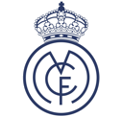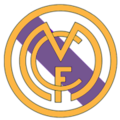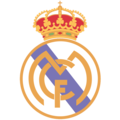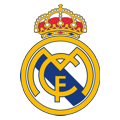![]()
Crests and Colours
Crests

1902
|

1908
|

1920
|

1931
|

1941
|

2002
|
The first crest had a simple design consisting of a decorative interlacing of the three initials of the club, "MCF" for Madrid Club de Fútbol, in dark blue on a white shirt. The first change in the crest occurred in 1908 when the letters adopted a more streamlined form and appeared inside a circle. The next change in the configuration of the crest did not occur until the presidency of Pedro Parages in 1920. At that time, King Alfonso XIII granted the club his royal patronage which came in the form of the title "Real Madrid," meaning "Royal." Thus, Alfonso's crown was added to the crest and the club styled itself Real Madrid Club de Fútbol.
With the dissolution of the monarchy in 1931, all the royal symbols (the crown on the crest and the title of Real) were eliminated. The crown was replaced by the dark mulberry band of the Region of Castile. In 1941, two years after the end of the Civil War, the crest's "Real Corona", or "Royal Crown", was restored while the mulberry stripe of Castile was retained as well. In addition, the whole crest was made full color, with gold being the most prominent, and the club was again called Real Madrid Club de Fútbol. The most recent modification to the crest occurred in 2001 when the club wanted to better situate itself for the 21st century and further standardize its crest. One of the modifications made was changing the mulberry stripe to a more bluish shade.
Colours
Real Madrid has maintained the white shirt for its home kit throughout the history of the club. There was, however, one season that the shirt and shorts were not both white. It was an initiative undertaken by Escobal and Quesada in 1925; the two were traveling through England when they noticed the kit worn by London-based team Corinthian F.C., one of the most famous teams at the time known for its elegance and sportsmanship. It was decided that Real Madrid would wear black shorts in an attempt to replicate the English team, but the initiative lasted just one year. After being eliminated from the cup by Barcelona with a 1–5 defeat in Madrid and a 2–0 defeat in Catalonia, President Parages decided to return to an all-white kit, claiming that the other kit brought bad luck. By the early 1940s, the manager changed the kit again by adding buttons to the shirt and the club's crest on the left breast, which has remained ever since. On 23 November 1947, in a game against Atlético Madrid at the Metropolitano Stadium, Real Madrid became the first Spanish team to wear numbered shirts. English club Leeds United permanently switched their blue shirt for a white one in the 1960s, to emulate the dominant Real Madrid of the era.


